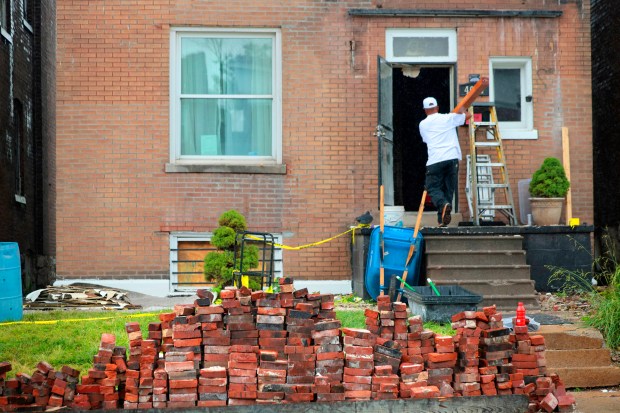I have a large blue spruce tree in front of my home. It is taller than my two-story home, and when I moved in eight years ago, it was a beautiful tree with only a few dying branches on the bottom 2 feet. This year, the dead branches extend up more than 6 feet. I’m worried about the progression of dead branches. What can I do?
—Layton Jackson, Evanston
It is so disconcerting to see a specimen tree going into decline. One of the prized oak trees in my yard appears to be declining, so I can relate to your concerns. Your description suggests that your Colorado blue spruce (Picea pungens ‘Glauca’) is suffering from cytospora canker, a disease caused by a fungus that attacks spruces, hemlocks, firs and larches. Cytospora canker generally appears on the lower branches first and then progresses up the tree. Individual upper branches may show these symptoms as well (as you are seeing in your blue spruce). Needles on infected branches turn purple, then brown. The brown needles may remain on the branches or fall off. Also, look for a hard, white residue on the lower branches that resembles bird droppings. This is resin from infected branches higher on the tree dripping down. On those higher branches, you also may find sunken, oozing cankers that are dripping the resin. The diseased needles will eventually fall off, and the infected branches will die over a period of time. This disease is most severe on Norway and Colorado blue spruce species and is most common on trees more than 15 years old. Your tree is probably older than 15 years, based on its size when you moved in eight years ago. The spores of the fungus that cause cytospora canker are disseminated by splashing water, wind-driven rain, and pruning.
The fungus causes no problem until the tree is stressed. That makes the disease more prevalent on trees of low vigor, which can be caused by low fertility, insect damage, shallow roots, drought, planting a tree in an improper site and mechanical injury. I have also seen what appears to by cytospora canker on blue spruce planted in challenging sites like parking lot islands and shaded areas in gardens. Cytospora canker occurs most often in trees that are drought-stressed. Trees can live many years with cytospora canker, although it does make them much less attractive. Infected branches cannot be saved and should be pruned off. Do this when the weather is dry or when the tree is dormant in winter, so the fungus spores do not spread through dampness. Disinfect your pruner and saw between cuts to reduce the chance of spreading the disease. Lysol disinfectant works well for this.
There are no chemical controls for cytospora canker, so maintenance practices that reduce stress and improve vigor are important. Prevent drought stress by supplying additional water during dry weather. The best thing to do now is to provide the tree with supplemental water for the rest of the season if conditions are dry. Add 2 to 3 inches of mulch if bare soil is under the tree. Prune out infected branches this winter and fertilize the tree in spring. Once the dead branches are removed, you will need to decide whether the tree is worth keeping. If you keep it, continue the enhanced maintenance routine, including watering, in future years.
For more plant advice, contact the Plant Information Service at the Chicago Botanic Garden at plantinfo@chicagobotanic.org.
Tim Johnson is senior director of horticulture at the Chicago Botanic Garden.




